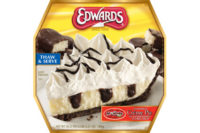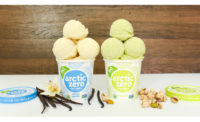Dairy processors are always looking for the next big thing, whether it’s a new packaging idea, inclusions or trendy new flavors. Take the hazelnut, for example. Nutella and Jif have had success with their hazelnut spreads, and now a flavored inclusion is available for ice cream.
At the International Dairy Show in Chicago in November, Wayland, Mich.-based Denali Flavors added a hazelnut flavor to its popular Moose Tracks ice cream formula. Denali also rolled out Salty Caramel Caribou.
The Hazelnut Moose Tracks is a combination of hazelnut-flavored ice cream, hazelnut-filled mini chocolate cups and Moose Tracks fudge. The Salty Caramel Caribou features salty toffee-flavored ice cream, with salty caramel-filled mini milk chocolate cups and Salty Caramel fudge.
This salted caramel flavor is another flavor trend that Dairy Foods has seen being used in everything from frozen desserts, ice cream, to yogurt.
Overcoming challenges
For frozen dessert processors, coming up with the hottest flavor trend isn’t the only thing to compete with or worry about. Making frozen desserts has its own set of challenges. Many dairy dessert manufacturers are striving for ways to improve the health profile of their product while maintaining the same flavor and texture experience for the customer, said Aaron Venables, Senior Research Scientist, FMC Health and Nutrition, Philadelphia.
According to FMC, air cell stabilization presents a challenge for frozen dessert processors, given the altitude abuse that is often related to the time and distance that some dairy dessert products have to travel to reach the shelves. FMC developed a microcrystalline cellulose ingredient that has the ability to stabilize air cells, reduce the degree of their coalescence and prevent air from leaching out of the product causing shrinkage. Venables said the ingredient is well-suited to dairy desserts because it enables a finer distribution of air cells within a product, which enhances the creaminess perception, which provides uniformity in texture and mouthfeel.
Crafting a great-tasting frozen dairy product requires a manufacturer to consider a number of factors, according to David Michael & Co., a flavor company based in Philadelphia. Along with taste, appearance is also vital to the success of any food or beverage. Because there are a number of ingredients that comprise most frozen dairy products, it’s important that the manufacturer knows how they interact, so that the finished product tastes as it was intended to, said Peggy Pellichero, senior food technologist/dairy team leader, David Michael. For example, the level of sweetness, along with the particular sweetener used, can impact the overall flavor profile. The same applies to both the stabilizer system and the percentage of butterfat used, as they can have an effect on flavor. This is where a flavor company can lend assistance in helping to develop the ideal formulation.
The trend today is toward natural flavors and natural colors, according to Pellichero. Depending on the product being made, some manufacturers may prefer not to use color. Mint chocolate chip ice cream would be a good example of this. When color is used, it needs to look appealing and not artificial. It’s also important to note that as over-run is increased, the product’s color may fade. The same holds true for flavor, which can also diminish as over-run increases. Earlier this year, David Michael introduced a new frozen dairy product concept it calls Sherbato. A combination sherbet and gelato, it was shown in lemon, tangerine and pink grapefruit. Sherbato delivers a tart citrus fruit flavor but retains the creamy texture and mouthfeel of gelato, according to the company.
Inclusions are hot
The competition in frozen desserts is fierce with new product rollouts hitting grocery shelves every day, said Jillian Hillard, marketing manager for PreGel America, a specialty dessert ingredient manufacturer and distributor based in Concord, N.C. Inclusions continue to gain traction as they provide balance of texture and added flavor.
“With the popularity of hybrid desserts, essentially combining two revered desserts into one, baked inclusions in frozen desserts are proving to find success and add that something extra,” said Hillard.
With this trend in mind, more cookie, cereal and pastry-based companies are looking for nontraditional markets in which to launch their products. Partnering with frozen dessert manufacturers is a win-win to bring about these exciting hybrid creations, said Hillard.
“Some of PreGel’s greatest successes in our line of inclusions called Arabeschi are our cookie-based products,” said Marco Casol, president, PreGel America. The company partnered with the Italian cookie company Grisbi to create a Lemon Cookie Crunch inclusion which is one of PreGel’s top sellers.
Working with baked inclusions in frozen desserts to yield success isn’t always a streamlined and easy process on the manufacturing side, said Hillard. According to PreGel’s R&D Technologist Erin Evans, the high moisture content in frozen desserts creates problems when it comes to baked inclusions because water is what can turn a crunchy cookie into a mushy mess. During the natural freeze and thaw process of frozen dessert manufacturing the structure breaks down, making water more readily available. Baked inclusions can absorb the moisture unless something is done to prevent absorption.
The key to incorporating baked inclusions into frozen desserts is maintaining their crispy and crunchy mouth feel. The best method of maintaining the texture is to create a barrier between the baked inclusion and the frozen dessert, according to Evans. This barrier (or sauce) must be thick enough to completely coat each inclusion and adhesive enough to stay bonded to the inclusion for extended periods of time. It will prevent moisture absorption by creating a matrix that binds any available water.
The added steps to create high-quality baked inclusions can often affect the overall costs of the ingredients, but the investment can pay off, said Hillard. Nostalgic baked inclusions, such as popular cereals and cookies, are leading the trend. More frozen dessert processors would be wise to get on board with combining baked inclusions. According to Hillard, this trend continues to grow in this competitive marketplace.






